Why You Should Allocate To Crypto Assets - An Institutional Investor's Approach
Crypto offers any portfolio a powerful tool for navigating today’s uncertain marketplace. The focus of this report will be in identifying the role that crypto can serve in a well-diversified investment portfolio. This analytical approach is the exact approach institutional money will take in order to study the risks and rewards of allocating to crypto assets.
MARKET INSIGHT
Volatility
Using the VIX as our measure of implied volatility, the markets have been complacent throughout extensive periods of the current bull market. As a result of this complacency, the short volatility trade grew into such an oversized trade that the recent blow up of short volatility products during a spike in the VIX was inevitable. The likelihood of a change in attitude towards volatility in the bond and equity markets is now very high, and this sets up a bullish framework for crypto as an asset class, whose detractors claim the asset’s volatility is the main reason for avoiding any sort of allocation.
With volatility set to return to the market – at least, with the awareness of volatility and its influence on markets being paid more attention to – it appears a shift in sentiment towards crypto’s volatility being a negative may begin to erode as other assets experience materially higher volatility. Investors may even turn bullish on crypto’s volatility, especially should it prove to be uncorrelated to the broader market, as I will prove to be true further in this report.
In any case, the argument that volatility in crypto is reason to avoid the space entirely is losing its credence. This is a trend that shows no signs of slowing.
Bond Market
Bond prices appear to be topping out as we have witnessed yields begin a well-defined upward trend in recent months. The fact that the USD has shown weakness while US treasury yields have risen should cause any investor to perk up and pay attention. For years, this relationship was inversely correlated. When the dollar weakened, capital flowed into bonds. When the dollar strengthened, capital flowed out of bonds back into USD. This relationship now shows possible signs of breaking down and its implications are paramount as the USD and US treasuries are considered the world’s safe haven assets.
Markets have begun to indicate that the US Federal deficit is alarmingly high and the safe haven of US treasuries may not be so safe indeed. This indication coincides with an era where the hegemony of the USD is being challenged by the Chinese, who wish to begin denominating their own gold and oil transactions in yuan, rather than USD.
While the roadmap for these larger than life trends are unclear and will require a significant amount of time to play out, these developments are clearly casting a shadow over the broader market.
Another cause of concern for holders of US treasuries is the diminishing marginal pool of buyers – central banks, the largest buyer of bonds, are now unwinding their bond buying programs – for newly issued US Treasury debt. As markets indicate bond prices will be materially lower in the years to come, the White House has shown its commitment to increasing debt issuance in order to stimulate the economy via increasing spending programs.
We stand at a point where the Treasury is set to increase bond supply, while the market is beginning to discount bond prices for the first time in decades. Increasing supply and decreasing prices are time tested indicators that investors ignore at their own peril.
Equity Market
Equity markets are equally exposed to these dynamics in the bond markets (if not more so) and should we experience a correction in the bond market, an equity sell off may occur in reaction. This correlation can be attributed to any number of reasons, but amongst the front runners as to why these markets are highly correlated include:
- Dominance of the risk parity trade (the strategy of investing in bonds/equities in calculated weighted amounts based on risk parameters).
- The unfettered growth of passive investing.
- Staggering amounts of capital being driven into private equity and venture capital.
- Demographics and the concern of if the 10,000 baby boomers retiring each day and drawing down their IRA’s will create a liquidity crunch and sell-side pressure.
Even larger than the reasons listed above lies the fact that valuations are very rich by nearly every metric and much of the recent momentum in this bull market is attributable to fewer and fewer stocks (FAANG’s and Defense Industry outperforming in the last year) signaling perhaps market breadth is diminishing with time, just as in every previous bull market.
While I will refrain from prognostication on the broad market in this report, it is clear that many market participants are beginning to question the foundation on which our current bull market has been built, and as a result, alternative assets are seeing reinvigorated interest.
MARKET COMMENTARY
The reason to mention these larger macroeconomic views is to point out one thing: the market is failing to find a safe haven asset in the current environment, and this dislocation in safety plays a very influential role in how the emergence of crypto assets will be perceived.
The primary case for allocating to crypto lies in its asymmetry, its lack of correlation to the broader market (offering hedging capabilities), and increasingly, its volatility.
It is a play on an emerging asset class that serves as a duopoly on technological advancement and new alternative assets, and it is a play on social narrative that is increasingly wary of our current credit based economic system digging itself further and further into debt whilst benefitting fewer and fewer in number.
CORRELATIONS
Before going any further, let me define which data sets I have based my analysis on, and which proxies I have used to define the performance of various asset classes.
- AGG (proxy for bonds)
- ASIAX (proxy for alternative investment strategies)
- BTC (proxy for crypto assets)
- DBC (proxy for commodities)
- GLD (proxy for gold)
- VNQ (proxy for real estate)
- VT/SPY (proxy for equities, aka stocks)
For many whom hold the view that gold is the only true safe haven asset class, crypto offers investors enhanced returns as a hedge to bonds, equities, commodities, real estate, as a store of value, and as an asset that can be held outside of the financial system.
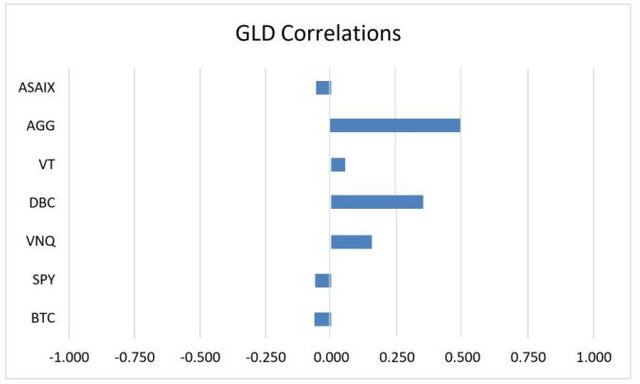
While gold is truly a time tested safe haven as compared to inflationary fiat, the fact is that gold carries a considerable correlation (0.5) to the bond market (AGG), and as discussed, the bond market is experiencing unprecedented issues with removing central bank bond buying programs from the equation. These issues are reflected in rising bond yields.
It is possible that the next major market event will be driven by action in the bond market, reason enough for any portfolio manager to consider hedging against bonds. Crypto assets offer this hedging ability better than that of gold and any other asset class, as illustrated below.
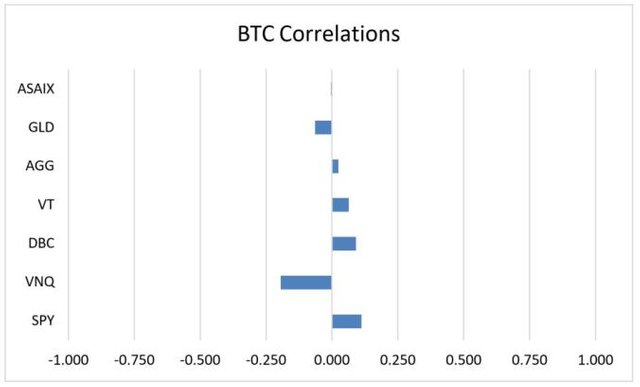
Bitcoin is virtually uncorrelated to any other asset class, offering unique hedging abilities as an investment vehicle. (Less than 0.1 correlation is statistically insignificant.)
REMINDER: In my analysis, I use Bitcoin as a proxy for the performance of all crypto assets.
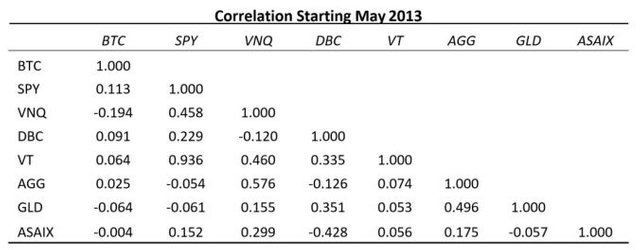
As the chart above illustrates, not only is Bitcoin uncorrelated to gold (GLD) and bonds (AGG), but also to equities (VT and SPY), commodities (DBC), real estate (VNQ), and alternative asset strategies (ASAIX), all of which are approaching the zero bound of correlation.
Bitcoin is truly in a class of its own in terms of offering uncorrelated returns while also allowing portfolios the ability to hedge against major bear markets in any of the aforementioned markets.
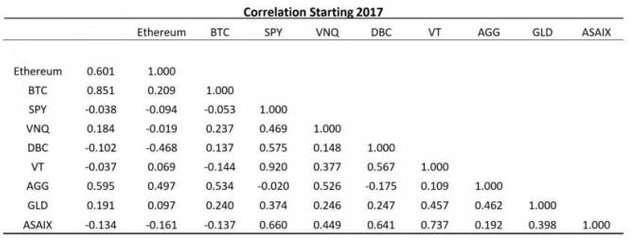
Bitcoin’s function as a proxy for the broad crypto market is appropriate for a few reasons.
(1) Bitcoin has the most available data going back to 2013, whereas newer assets have limited data.
(2) To date, the broad crypto market has followed Bitcoin’s performance closely.
(3) Most other crypto assets are denominated in price relative to Bitcoin, in addition to fiat.
(4) More often than not, investors must purchase Bitcoin in order to purchase other crypto assets meaning that Bitcoin volumes reasonably reflect ecosystem activity.
For more motivated investors, there exists the possibility to gain exposure to additional alpha over Bitcoin via more recent, high-growth crypto assets with smaller market capitalizations that allow for faster appreciation. However, this analysis focuses on the larger trend of capital flowing into the ecosystem via Bitcoin, first and foremost.
PORTFOLIO PERFORMANCE
Our baseline portfolio will be constructed from the following:
- 55% Vanguard Total World Market ETF (VT)
- 35% iShares Barclays Aggregate Bond ETF (AGG)
- 5% SPDR Gold (GLD)
- 5% AQR Multi-Strategy Alternative Fund (ASAIX)
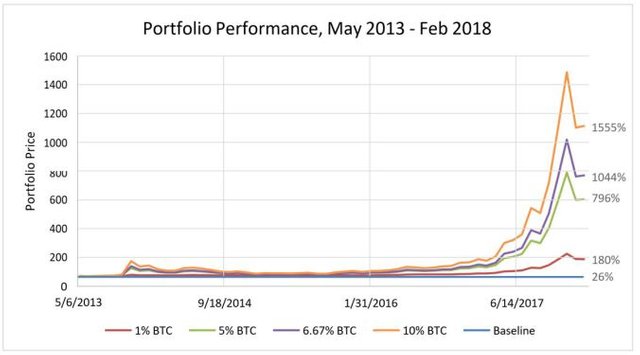
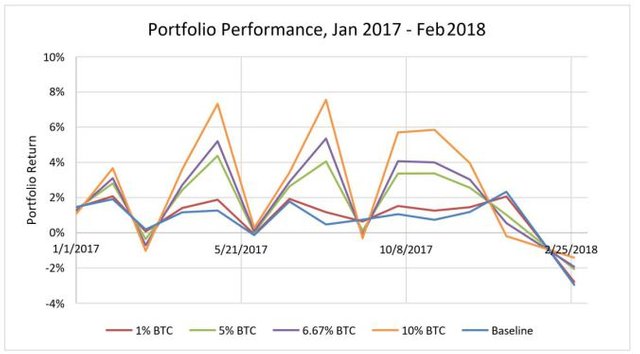
As you can see, the hypothetical addition of a small allocation towards crypto assets within our baseline portfolio model results in staggering gains on the longer time horizon. Such large gains, in fact, that should a small strategic allocation to crypto assets perform as well as they have to date, a 1% allocation could come to represent upwards of 60% of your portfolio’s total yield.
Yet, even in an environment where the broad market is in decline (see 2018 YTD chart), a crypto allocation reduces losses and generally serves to mitigate total portfolio risk.
This is the very definition of an asymmetric investment: one in which a small amount of capital can result in portfolio defining capital gains, all while minimizing risk exposure via small allocations and generally uncorrelated sources of yield.
Although institutional investors are hesitant to allocate to crypto assets due to their perceived risk, the data indicates that not only does crypto enhance risk adjusted gains for a well-diversified portfolio, but it also allows investors a hedging vehicle in a market where the possibility of a risk off event rippling through bonds, equities, commodities, gold, real estate, and other alternative assets is growing by the day.
Crypto assets are truly in a class of their own in offering unmatched yield producing abilities in a low-yield environment, while also allowing investors the ability to pursue uncorrelated yield sources.These two aspects alone suggest crypto assets deserve to become an allocation for a growing number of well-diversified investment portfolios.
CONCLUSION
This analysis proves that crypto assets are uncorrelated to the broad market, offer high yield, and although volatile, ought to be included as an allocation in well-diversified investment portfolios.
My research has used Bitcoin as a proxy for crypto assets as a whole, yet further crypto portfolio diversification offers investors the ability to outperform Bitcoin moving forward as the market awareness of crypto as an asset class grows, and investors in the space will look to diversify their crypto allocation even further beyond Bitcoin.
Nowhere is this the growth of this market awareness more evident than in the number of users at popular online exchanges (Coinbase), in hardware wallet purchases, Google searches, news coverage, and in central bank meeting minutes.
In other words, we are experiencing high-growth in an emerging asset class, all without the existence of a mainstream ETF or other easy-access vehicle. The floodgates are poised to fall within 2018, and once they do it is quite likely that a number of the other alt-coins in the space shall perform as Bitcoin has to date. Most specifically, those alts that can acquire the largest number of users and tackle the largest markets.
All anyone needs to access the crypto asset market is the ability to use the internet. There are well over 3 Billion people with this ability, and it is only going to accelerate moving forward, especially as emerging economies leap frog previous technologies. With more users comes increased liquidity within the asset class, and with more liquidity comes a better price discovery mechanism. All signs indicate that this price discovery has yet to occur, as we are still in the market awareness discovery phase.
The market is set to mature, and as the data has proven, Bitcoin will not be the only asset worth allocating to within an asset class, as a whole, that deserves to be allocated to within a well- diversified portfolio in search of yield in an environment that is increasingly yield adverse.
Methodology Explained
First and foremost, the covariance/correlation between the various asset classes needed to be found. I accomplished this by sorting the data out into both weekly and monthly percentage changes. This was easier said than done (thanks to crypto markets being 24/7 versus traditional markets only weekdays). However, with the data sorted I was able to use the excel function for correlation to solve for correlation between Bitcoin and GLD, VT, etc. and create a matrix showing each relationship.
Graphing these charts from the matrix was straightforward.
The next portion of the process was to introduce various crypto allocations to the baseline portfolio. While my charts only indicate the allocation size (1%, 5%, 6.67%, and 10%) I neglect to explain where the reweighting stemmed from. Please see below chart.


The reasoning behind each of these changes were more qualitative in nature, versus quantitative. To be honest, this is the first place I would spend more time researching. There certainly exists an optimal allocation amount, yet I based my allocation weightings based upon where I felt most fund managers would be willing to lighten up (i.e. bonds or alt assets), or deploy capital more liberally.
It is worth noting that in my analysis I have taken a rather biased view on GLD (as a proxy for gold). Make no mistake, gold has it's own unique purpose in each portfolio. Gold is insurance, and it ought to be treated as such. Gold maintains purchasing power for its holder, and although it may lose value in fiat dollar terms, it has proven throughout history to gain value in relative terms just as fiat loses relative value, which is why it is the preferred store of value method all around the world. Gold also carries no risk of cyber espionage (which is a big deal - see my cyber weekly posts), so long as you physically hold your gold.
Yet, as my analysis has proven, Bitcoin (as a proxy for crypto assets) is uncorrelated to other asset classes, and it has the advantage of having much smaller market awareness (double-edged sword) and a smaller market capitalization, which means it has the potential to appreciate in value in rapid fashion. This is an asymmetric investment play, as it has no true correlation to the broad market, and even though as it has been said before that this correlation has yet to be truly tested in a state of market panic, or general loss of confidence, the asset class warrants investment due to it's potential staggering payoff relative to its risk profile.
In conclusion, crypto assets are set to explode in value as institutional funds enter the space using the same roadmap I have laid out for you here. I recommend you beat them to the punch, and get your money there first. It also goes without saying that each and every man, woman, and child ought to consider holding physical gold and silver as well, just for the rainy day that comes in each fiat currency's life cycle.
DISCLAIMER : This content is for informational, educational and research purposes only. This post is not to be taken as personalized investment advice.
If you found this interesting, please up-vote and chime in via the comments. If not, feel free to forward this to your frenemies.
For anyone new to my work, I highly encourage you to revisit my previous articles, especially this one!
1 - Follow the Money - An Approach to Investing (And Life)
2 - Anybody Can Invest Successfully
3 - Pitfalls of Passive Investing
4 - The Importance of Limit Orders
5 - Learning? How About Earning? (Part 1)
6 - Learning? How About Earning? (Part 2)
7 - Cheat Sheet: Where to Invest Now (And Where Not To)
8 - A Tool to Avoid Investing Clickbait
9 - The Devil is in the Details (Part 1)
10- The Devil is in the Details (Part 2)
11- The Big Picture With Crypto
12- Are We Experiencing A Crypto Bubble?
13- How To Invest in Crypto Securely
14- Cultivation of Convenience: Thoughts on Privacy
15- Crypto's Network Effect and Types of Crypto Investors
16- Bull or Bear? Doesn't Matter
17- Trends to Watch in Crypto: Derivatives, ETF's, and China
18- Why Volatility is A Friend to Crypto
19- Cyber Realm is A Broken Arrow: 2018 Prediction
20- The Arbitrage of Intimidation and Misunderstanding: Why You Should Educate Yourself
@originalworks. FWIW, I put a great deal of effort into this report. Please feel free to share!